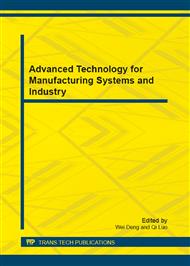[1]
D. Coppersmith, A. Shamir, Lattice Attacks on NTRU, Advances in Cryptology EUROCRYPT. Berlin Heidelberg: Springer-Verlag, LNCS, 1997, 1233: 52-61.
DOI: 10.1007/3-540-69053-0_5
Google Scholar
[2]
J. Hoffstein, J Pipher, J. Silverman, NTRU: A Ring Based Public Key Cryptosystem, Proceedings of ANTS 3 (1998), Berlin Heidelberg: Springer-Verlag, LNCS, 1998, 1423: 267-288.
DOI: 10.1007/bfb0054868
Google Scholar
[3]
T. Meskanen, A. Renvall, A wrap error attack against NTRUEncrypt, Discrete Applied Mathematics, 2006, 154(2): 382–391.
DOI: 10.1016/j.dam.2005.03.019
Google Scholar
[4]
C. Gentry, Key recovery and message attacks on NTRU-composite, International Conference on the Theory and Application of Cryptographic Techniques, Advances in Cryptology EUROCRYPT 2001: 182-194.
DOI: 10.1007/3-540-44987-6_12
Google Scholar
[5]
E. Jaulmes, A. Joux, A Chosen-Ciphertext Attack against NTRU, Proceedings of Crypto'00, Berlin Heidelberg: Springer-Verlag, LNCS, 2000, 1880: 20-35.
DOI: 10.1007/3-540-44598-6_2
Google Scholar
[6]
N. Gama, P. Q. Nguyen, New Chosen-Ciphertext Attacks on NTRU, 10th International Conference on Practice and Theory in Public-key Cryptography, Berlin, Heidelberg: Springer-Verlag, 2007: 89-106.
DOI: 10.1007/978-3-540-71677-8_7
Google Scholar
[7]
J. Hoffstein, J H. Sliverman, Optimizations for NTRU, Proceedings of the International Conference on Public-key Cryptography and Computation Number Theory. Berlin, NewYork : De Gruyter, (2001).
Google Scholar
[8]
J. Hoffstein, J. H. Silverman, Protecting NTRU against chosen ciphertext and reaction attacks, Technical report, NTRU Cryptosystems, (2000).
Google Scholar
[9]
P. Nguyen, D. Pointcheval, Analysis and improvements of NTRU encryption paddings, In Advances in Cryptology-CRYPTO2002, Berlin Heidelberg: Springer-Verlag, LNCS, 2002, 2442: 210-225.
DOI: 10.1007/3-540-45708-9_14
Google Scholar
[10]
D. Stehle, R. Steinfeld, Making NTRU as Secure as Worst-case Problems over Ideal Lattice, EUROCRYPT (2010). Berlin Heidelberg: Springer-Verlag, LNCS, 2011, 6630: 27-47.
DOI: 10.1007/978-3-642-20465-4_4
Google Scholar
[11]
R. A. Perlner, D. A. Cooper, Quantum resistant public key cryptographer: a survey, Proceedings of IDtrust '09, New York: ACM, 2009: 85-93.
Google Scholar
[12]
C. Peikert, B. Waters, Lossy trapdoor functions and their applications, Proceedings of the 40th ACM Symp. on Theory of Computing(STOC), 2008: 187-196.
DOI: 10.1145/1374376.1374406
Google Scholar
[13]
C. Peikert, Public-key cryptosystem form the worst-case shortest vector problem, Proceedings of 41st ACM Symp. on Theory of Computing(STOC), (2009).
DOI: 10.1145/1536414.1536461
Google Scholar
[14]
E. Fujisaki, T. Okamoto, Secure integration of asymmetric and symmetric encryption scheme, Proceedings of Crypto'99, Berlin Heidelberg: Springer-Verlag, LNCS, 1999, 1666: 537-554.
DOI: 10.1007/3-540-48405-1_34
Google Scholar
[15]
D. Micciancio, S. Goldwasser, Complexity of Lattice Problems: A Cryptographic Perspective, The Kluwer International Series in Engineering and Computer Science. Boston, Massachusetts: Kluwer Academic Publishers, 2002, 671.
Google Scholar
[16]
D. Micciancio, Generalized compact knapsacks, cyclic lattice, and efficient one-way functions, Computational Complexity, 2007, 16 (4): 365-411.
DOI: 10.1007/s00037-007-0234-9
Google Scholar
[17]
D. Micciancio, O. Regev, Worst-case to average case reduction based on Gaussian measures, SIAM Jounal on Computing, 2007, 37 (1): 267-302. Preliminary version in FOCS (2004).
DOI: 10.1137/s0097539705447360
Google Scholar
[18]
V Lyubashevsky, C. Peikert and O. Regve, On ideal lattice and learning with errors over rings, EUROCRYPT 2010. Berlin Heidelberg: Springer-Verlag, LNCS, 2010, 6110: 1-23.
DOI: 10.1007/978-3-642-13190-5_1
Google Scholar
[19]
O. Regev, On lattices, learning with errors, random linear codes, and cryptography, Journal of the ACM, 2009, 56 (6): 34. Preliminary version in STOS'05.
DOI: 10.1145/1568318.1568324
Google Scholar
[20]
Nick Howgrave-Graham, J, H. Silverman and W. Whyte, Choosing Parameters Sets for NTRUEncrypt with NAEP and SVES-3, Proceedings of CT-RSA (2005), Berlin Heidelberg: Springer-Verlag, LNCS, 1997, 3376: 118-136.
DOI: 10.1007/978-3-540-30574-3_10
Google Scholar


